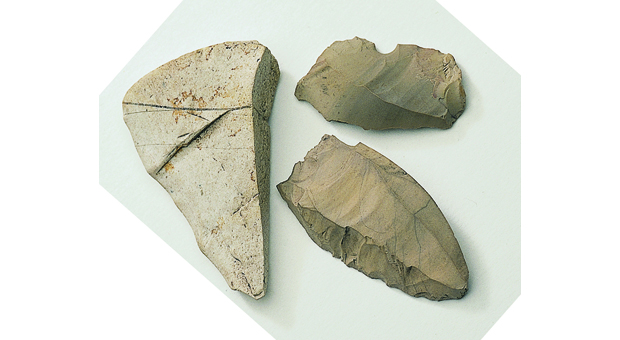Author: Paul Irish and Tamika Goward
The Rocks area is mainly known as a place of early European history, but it was also used by Aboriginal people for many years before colonial settlement. Traces of an Aboriginal campsite have been found near the intersection of Cumberland and Essex streets. The campsite was discovered next to the historic Lilyvale Cottage during archaeological excavations carried out in 1989 ahead of the construction of the Shangri-La Hotel. During the excavation some shells became visible, which were found to represent an Aboriginal midden.
Middens are mounds of discarded food waste (shellfish, fish and land animals) that have been left by Aboriginal people camping near the coast. They may be the result of a single meal or the continued use of a camp over a long period of time. They can also contain the remains of cooking fires, stone, bone and shell tools, and sometimes human burials. They are important sources of information for archaeologists because the lime-rich shells aid in the preservation of fish bones and other food remains that would otherwise quickly disintegrate in the soil.
The midden at Lilyvale was located about 65cm beneath the ground surface, below some old footings next to the cottage. It was small but intact, consisting of a thin layer of shell with some fish bones and pieces of charcoal spread over an area of a metre by a metre. Rock oyster and hairy mussel were the most common shellfish among more than a dozen species in the midden, which also contained the bones of fish such as snapper and bream. The small size of the midden tells us that it was only used briefly, perhaps just for a single meal. Radiocarbon dates from the midden show that the campsite at Lilyvale was used fairly recently, about 340 years before the First Fleet arrived in Sydney in 1788.
The midden was located on a rocky ridge about 30 metres above the waters and rocky shores of Darling Harbour and Circular Quay, where all of the food types within the midden would have been available. With its panoramic views, nearby freshwater along the Tank Stream and supply of food, it would have been an ideal position to stop for a meal or to camp for a longer period.
References
W Thorp, 1991. Archaeological Report. Excavations at Lilyvale Cottage and the Butchery Building. Cumberland Street, The Rocks, Sydney (Report to CRI Project Management).
V Attenbrow, 1992. ‘Shell Bed or Shell Midden’, Australian Archaeology 34:3-21.
AHIMS ID Number 45-6-1853.







